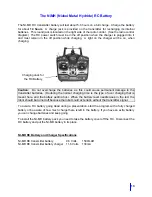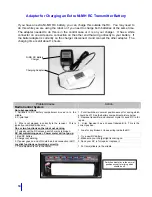
19
!
Warnings
1.
Do not unplug or plug in the DC power plug on the robot receiver with the robot
power on.
If the power is left on, the plug will short out and could damage the receiver.
The fuse in line on the power wire that is plugged into this receiver may blow. This fuse is a
round black fuse holder. If this fuse is not blown but no RX power light is on, check the
audio fuse on the main fuse block in the electronics box.
2. Do not leave the voice units in direct sunlight or in a damp place for any length of time.
3. Remove batteries if voices will not be used for an extended period of time.
4. Keep voices and headset in the carrying case when not in use.
5. Generally when the robot is on, the operator's transmitter should be on. This will avoid the
receiver on the robot picking up radio frequency interference and putting out static (see
intermittent static problem of Voice System Troubleshooting).
6. Turn off the 151 receiver or remove the headset before turning off the robot. You can get a
squelch in your headset when you turn off the robot.
Troubleshooting the Voice
For any voice problem, perform the following steps first:
1. Check to see that the batteries are good in the operator's transmitter and in the 151
receiver. Normally when you turn the 151 receiver on, the low battery light should blink on
and go off. When turning on the power switch of the transmitter, the light should blink on
and go off. If either of these lights stays on constant, the 9-volt battery is too low and must
be replaced.
2. Check that the battery is in the correct polarity and confirm that the battery contacts are
making a solid connection to the spring clips inside the compartment. Bend them out
slightly if necessary. If the battery is making intermittent contact in the Transmitter, try a
different brand battery. Certain brand batteries are bigger than others.
3. Check all switch positions both on the operator and robot voice units. This includes the
audio and the power switches. See the Voice Unit Diagrams for details about the correct
position of these switches.
4. Check all plugs to and from the voices for proper connection.
5. Check the LED lights. When operating normally, the Receiver in the robot has a red TX light
on. The UHF10 or UHF4 Receiver has two LEDs, A and B to indicate that a signal is being
received. The 151 Receiver has a green TX light. These lights indicate that a signal is
being sent from the respective transmitter and that the receiver is receiving this signal.
See the next page for specific problems and their solutions.
Содержание Vehicle Robot
Страница 53: ...49 APPENDIX A ...
Страница 57: ...53 Robot Block Diagram ...
Страница 58: ...54 APPENDIX B ROBOT PARTS IDENTIFICATION ...
Страница 77: ...73 APPENDIX C CHECKLIST AND MAINTENANCE FORMS ...
Страница 79: ...75 ...
Страница 80: ...76 Notes ...
Страница 81: ...77 Technical Tips ...
















































